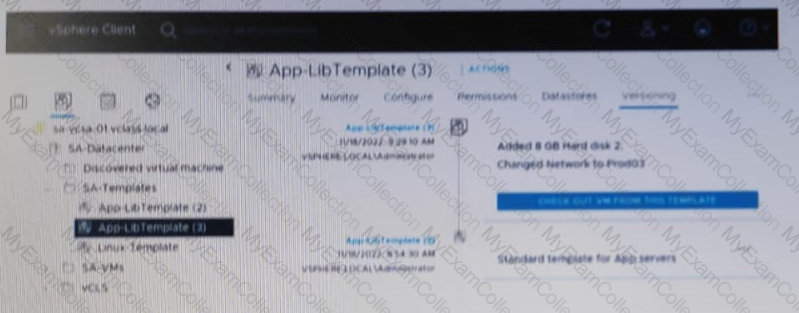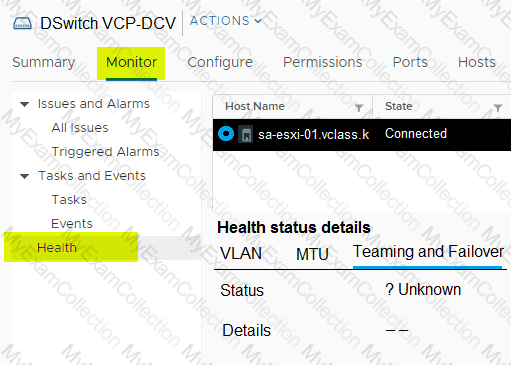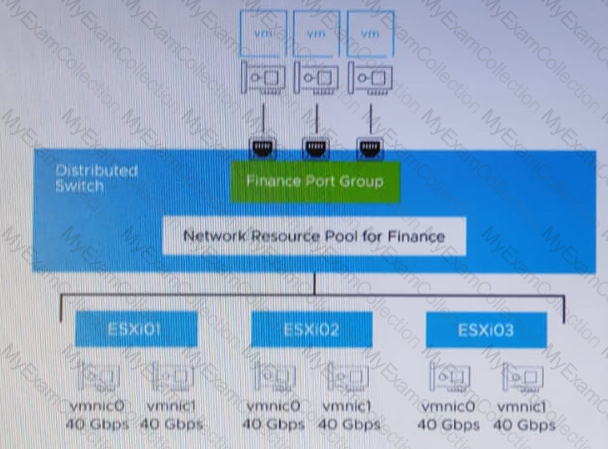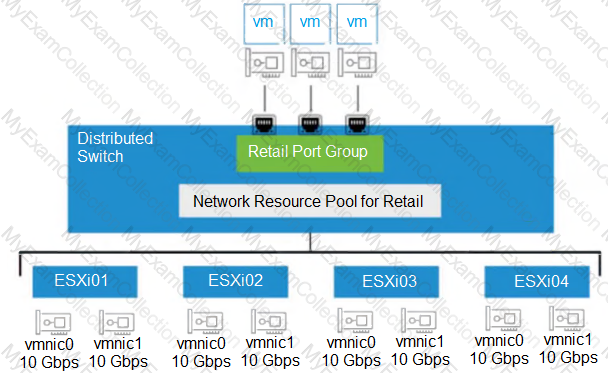Refer to the exhibit.

Given the configuration shown in the exhibit, what must the administrator do to delete only the latest version of the template?
An administrator is tasked with allowing a single user the ability to take snapshots on a virtual machine. When looking in vCenter, the administrator can see that there are already users and groups assigned permissions on the virtual machine as follows:
•The group VMJJsers has the Virtual Machine Power User role.
•The group VM_Viewers has the Read Only role.
The administrator confirms that the user requesting the additional access is currently one of five members of the VM_Viewers group
Which two steps should the administrator take to grant this user the additional access required without impacting the user access of others? (Choose two.)
An administrator remotely deploys VMware ESXi using an out of band management connection and now needs to complete the configuration of the management network so that the host is accessible through the vSphere Host Client.
The following information has been provided to complete the configuration:
•Host FQDN esxi01corp.local
•Management VLAN ID: 10 DHCP: No
•Management IP Address: 172.16.10.101/24
•Management IP Gateway: 172.16.10.1
. Corporate DNS Servers: 172 16.10.5, 172.16.10..6
•DNS Domain: corp.local
In addition, all host configurations must also meet the following requirements:
•The management network must use only IPv4 network protocols.
•The management network must be fault tolerant
Which four high level tasks should the administrator complete in the Direct Console User Interface (DCUI) in order to meet the requirements and successfully log into the vSphere Host Client? (Choose four.)
An administrator has Windows virtual machines (VMs) and VMware Tools is installed in each VM. The administrator performs a status check of VMware Tools using vSphere Lifecycle Manager.
What is the VMware Tools status for the Windows VMs if the version of VMware Tools has a known problem and must be immediately upgraded?
What is the minimum network throughput in Gb/s for vSAN using the Express Storage Architecture (ESA)?
An administrator is tasked with migrating a single virtual machine (VM) from an existing VMware vCenter to a secure environment where corporate security policy requires that all VMs be encrypted. The secure environment consists of a dedicated vCenter instance with a 4-node vSphere cluster and already contains a number of encrypted VMs.
Which two steps must the administrator take to ensure the migration is a success? (Choose two.)
An administrator is tasked with looking into the disaster recovery (DR) options for a software-defined data center (SDDC).
The following requirements must be met:
•All virtual machines (VMs) must be protected to a secondary site.
•The source VMs must remain online until the failover.
•When failing over to the secondary site, application downtime is allowed
•The DR failover must be managed from the vSphere Client.
•Costs must remain as low as possible.
How can the administrator accomplish this task?
A vSphere cluster hosts a three-tier application. The cluster has 50% resources available. If a host in the cluster fails, the database server must be online before the application server, and the application server must be online before the Web server.
Which feature can be used to meet these requirements?
An administrator is tasked with applying updates to a vSphere cluster running vSAN using vSphere Lifecycle Manager. Downtime to the ESXI hosts must be minimal while the work Is completed.
The administrator has already completed the following steps and no errors have been returned:
• Downloaded all applicable software and created a new Image
• Attached the new Image to the cluster and run a compliance check against the Image for the cluster
• Ran a remediation pre-check for the cluster
Which two series of steps should the administrator perform to start the remediation of the cluster using the new image? (Choose two.)
An administrator is configuring vSphere Lifecycle Manager to install patches to a vSphere cluster. The cluster runs workload virtual machines (VMs) that are incompatible with vSphere vMotion, and therefore cannot be live migrated between hosts during the installation of the patches.
Which configuration in vSphere Lifecycle Manager will allow the administrator to reduce the downtime associated with the patching operation without migrating the VMs?
An administrator has configured Storage I/O Control (SIOC) on a Virtual Machine File System (VMFS) datastore.
•The datastore supports 30,000 IOPS
•Storage I/O Control has been set to manual
•Storage I/O Control is triggered when latency hits 30 ms
•The datastore contains 3 virtual machines (VMs)
•A gold tier VM
•A silver tier VM
•A bronze tier VM
Assuming the datastore latency does not exceed 29ms, what is the maximum number of IOPS the bronze tier VM is entitled to?
An administrator is preparing to perform an update to vSphere clusters that are running vSAN. The administrator wants to ensure that the following requirements are met as part of the update:
•All hosts in the cluster are updated with the same software.
•The firmware versions on the hosts are updated
•The new software versions are checked for compliance against the vSAN Hardware Compatibility List.
Which three steps should the administrator take to meet these requirements? (Choose three.)
An administrator is tasked with looking into the disaster recovery options for protecting a database server using VMware vSphere Replication.
The following requirements must be met:
• The virtual machine must remain online during the protection.
• The virtual machine's snapshots must be used as part of the replication process.
Which step must the administrator complete to accomplish this task?
An administrator is attempting to configure Storage I/O Control (SIOC) on five datastores within a vSphere environment. The administrator is being asked to determine why SIOC configuration completed successfully on only four of the datastores.
What are two possible reasons why the configuration was not successful? (Choose two.)
An administrator is tasked with moving an application and guest operating system (OS) running on top of a physical server to a software-defined data center (SDDC) in a remote secure location.
The following constraints apply:
• The remote secure location has no network connectivity to the outside world.
• The business owner is not concerned if all changes in the application make it to the SDDC in the secure location.
• The application's data is hosted in a database with a high number of transactions.
What could the administrator do to create an image of the guest OS and application that can be moved to this remote data center?
Exhibit switch

An administrator configures a distributed switch and adds the first VMware ESXi server to it.
The administrator also performs the following activities:
•The administrator assigns two uplinks to the distributed switch.
•The administrator enables uplink teaming.
When attempting to perform a health check of the teaming policy, the health status of the Teaming and Failover reports as ' Unknown?, as seen in the exhibit.
What can the administrator changes in the distributed switch for the health status to report correctly?
Refer to the exhibit.

An administrator set up the following configuration:
• The distributed switch has three ESXi hosts, and each host has two 40 Gbps NICs.
• The amount of bandwidth reserved for virtual machine (VM) traffic is 6 Gbps.
The administrator wants to guarantee that VMs in the Finance distributed port group can access 50 percent of the available reserved bandwidth for VM traffic. k
Given this scenario, what should the size (in Gbps) of the Finance network resource pool be?
An administrator decides to restore VMware vCenter from a file-based backup following a failed upgrade. Which interface should the administrator use to complete the restore?
After a recent unexplained peak in virtual machine (VM) CPU usage, an administrator is asked to monitor the VM performance for a recurrence of the issue.
Which two tools can the administrator use? (Choose two.)
Refer to the exhibit.

An administrator set up the following configuration:
• The distributed switch has four ESXi hosts, and each host has two 10 Gbps NICs.
• In the Network I/O Control configuration, the amount of bandwidth reserved for virtual machine (VM) traffic if 4 Gbps.
The administrator wants to guarantee that VMs in the Retail distributed port group can access 50 percent of the available reserved bandwidth for VM traffic.
Given this scenario, what should the size (in Gbps) of the Retail network resource pool be?
An administrator is investigating user logon failures for a VMware vCenter instance
Where can the administrator find log files containing information related to user login activities?
An administrator is deploying a new all flash vSAN cluster based on the vSAN Original Storage Architecture (OSA).
What is the minimum supported network throughput in Gb/s for each host?
To keep virtual machines (VMs) up and running at all times in a vSphere cluster, an administrator would like VMs to be migrated automatically when the host hardware health status becomes degraded.
Which cluster feature can be used to meet this requirement?
An administrator needs better performance and near-zero CPU utilization from the ESXI hosts for networking functions and processing. The administrator creates a new vSphere Distributed Switch and enables network offloads compatibility.
Which solution would help achieve this goal?
An administrator is asked to segregate virtual machine (VM) traffic by VLAN on a vSphere standard switch The following requirements must be met:
•VLAN ID on the switch port group must be 4095.
•VLAN tagging must be done at the VM level.
Which tagging mode is required?

